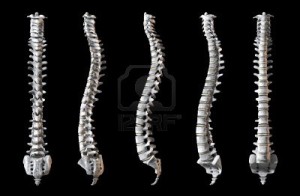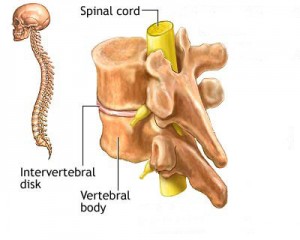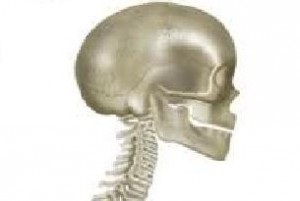What Does a Human Spine Look Like
The human spine is made up of 33 vertebrae, but how do they support our bodies while allowing us such flexibility?
The human spine is made up of 33 vertebrae, 24 of which are articulated (flexible) and nine of which normally become fused in maturity. They are situated between the base of the skull to the pelvis, where the spine trails off into the coccyx – an evolutionary remnant of a tail our ancestors would have displayed.
The primary functions of the vertebrae that make up the spine are to support the torso and head, which protect vital nerves and the spinal cord and allow the individual to move. By sitting closely together, separated only by thin intervertebral discs which work as ligaments and effectively form joints between the bones, the vertebrae form a strong pillar structure which holds the head up and allows for the body to remain upright. It also produces a base for ribs to attach to and to protect vital internal organs in the human body.
Vertebrae are not all fused together because of the need to move, and the vertebrae themselves are grouped into five types – cervical, thoracic, lumbar, sacral and coccygeal. The sacral vertebrae fuse during maturity (childhood and teenage years) and become solid bones towards the base of the spine. The coccygeal vertebrae will fuse in some cases, but studies have shown that often they actually remain separate. Collectively they are referred to as the coccyx (tail bone).
 The rest of the vertebrae remain individual and discs between them allow them to move in various directions without wearing the bones down. The cervical vertebrae in the neck allow particularly extensive movement, allowing the head to move up and down and side to side. The thoracic are far more static, with ties to the rib cage resisting much movement. The lumbar vertebrae allow modest side-to-side movement and rotation. A particular feature of the spine is how it is actually curved to allow distribution of the body’s weight, to ensure no one vertebrae takes the full impact.
The rest of the vertebrae remain individual and discs between them allow them to move in various directions without wearing the bones down. The cervical vertebrae in the neck allow particularly extensive movement, allowing the head to move up and down and side to side. The thoracic are far more static, with ties to the rib cage resisting much movement. The lumbar vertebrae allow modest side-to-side movement and rotation. A particular feature of the spine is how it is actually curved to allow distribution of the body’s weight, to ensure no one vertebrae takes the full impact.
Spinal cords and nerves
 The human spinal cord is an immensely complex structure made up of nerve cells and a large amount of supporting, protective tissue. It splits into 31 different sections and stretches 43-45cm, down from the brain to between the first and second lumbar vertebrae. Although more commonly referred to in respect of the brain, there is both white and grey matter present in the centre of the spinal cord. White matter contains axons tracts surrounded by fats, and blood vessels to protect them. The grey matter contains more of the neural cell bodies, such as dendrites, more axons and glial cells.
The human spinal cord is an immensely complex structure made up of nerve cells and a large amount of supporting, protective tissue. It splits into 31 different sections and stretches 43-45cm, down from the brain to between the first and second lumbar vertebrae. Although more commonly referred to in respect of the brain, there is both white and grey matter present in the centre of the spinal cord. White matter contains axons tracts surrounded by fats, and blood vessels to protect them. The grey matter contains more of the neural cell bodies, such as dendrites, more axons and glial cells.
Spinal cord injuries are normally caused by trauma. If the trauma causes intervertebral discs and vertebrae to break, they can pierce the spinal cord, which can result in loss of feeling. Cord severance may result in paralysis.
Spine curvature
As you look at the human spine, you can see some distinct curves. The primary reasons for these are to help distribute weight throughout the spine and support aspects of the body. The curve most familiar to us is the lumbar curve, between the ribs and pelvis. This develops when we start to walk at about 12-18 months and helps with weight distribution during locomotion. Prior to this we develop the cervical curve, which allows us to support the weight of our head at around three to four months, and two smaller less-obvious curves in the spine (the thoracic and pelvic curves) are developed during gestation.
![Skull and spine Skull and spine]() How is the skull attached to the spine?
How is the skull attached to the spine?
The skull is connected to the spine by the atlanto-occipital joint, which is created by CI (atlas) and the occipital bone situated at the base of the cranium (skull).
This unique vertebra has no ‘body’ and actually looks more like a ring than any other vertebra. It sits at the top of the cervical vertebrae and connects with the occipital bone via an ellipsoidal joint, allowing movement such as nodding or rotation of the head. An ellipsoidal joint is where an ovoid connection (in this case the occipital bone) is placed into an elliptical cavity (CI vertebrae). The rest of the cervical vertebrae also work to support the weight of the head.

